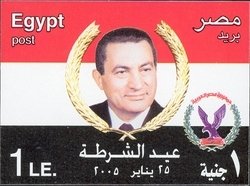Souvenir Sheet: Portrait of Pres. H. Mubarrak (Egypt 2005)
Portrait of Pres. H. Mubarrak (Egypt 2005)
25 January (Egypt ) within release Police goes into circulation Souvenir Sheet Portrait of Pres. H. Mubarrak face value 1 Egyptian pound
| Souvenir Sheet Portrait of Pres. H. Mubarrak in catalogues | |
|---|---|
| Michel: | Mi:EG BL88 |
| Yvert et Tellier: | Yt:EG BF95 |
| WADP Numbering System - WNS: | WAD:EG006.05 |
Souvenir Sheet is horizontal format.
Also in the issue Police:
- Stamp - Portrait of Pres. H. Mubarrak face value 30;
- Souvenir Sheet - Portrait of Pres. H. Mubarrak face value 1;
Souvenir Sheet Portrait of Pres. H. Mubarrak it reflects the thematic directions:
A head of state (or chief of state) is the public persona that officially represents the national unity and legitimacy of a sovereign state. In some countries, the head of state is a ceremonial figurehead with limited or no executive power, while in others, the head of state is also the head of government. In countries with parliamentary governments, the head of state is typically a ceremonial figurehead that does not actually guide day-to-day government activities and may not be empowered to exercise any kind of secular political authority (e.g., Queen Elizabeth II as Head of the Commonwealth). In countries where the head of state is also the head of government, the president serves as both a public figurehead and the actual highest ranking political leader who oversees the executive branch (e.g., the President of the United States).
A flag is a piece of fabric (most often rectangular or quadrilateral) with a distinctive design that is used as a symbol, as a signaling device, or as decoration. The term flag is also used to refer to the graphic design employed, and flags have since evolved into a general tool for rudimentary signalling and identification, especially in environments where communication is similarly challenging (such as the maritime environment where semaphore is used). National flags are patriotic symbols with varied wide-ranging interpretations, often including strong military associations due to their original and ongoing military uses. Flags are also used in messaging, advertising, or for other decorative purposes. The study of flags is known as vexillology, from the Latin word vexillum, meaning flag or banner.
The police are a constituted body of persons empowered by a state with the aim of enforcing the law and protecting the public order as well as the public itself.This commonly includes ensuring the safety, health, and possessions of citizens, and to prevent crime and civil disorder Their lawful powers encompass arrest and the use of force legitimized by the state via the monopoly on violence. The term is most commonly associated with the police forces of a sovereign state that are authorized to exercise the police power of that state within a defined legal or territorial area of responsibility. Police forces are often defined as being separate from the military and other organizations involved in the defense of the state against foreign aggressors; however, gendarmerie are military units charged with civil policing.Police forces are usually public sector services, funded through taxes.


